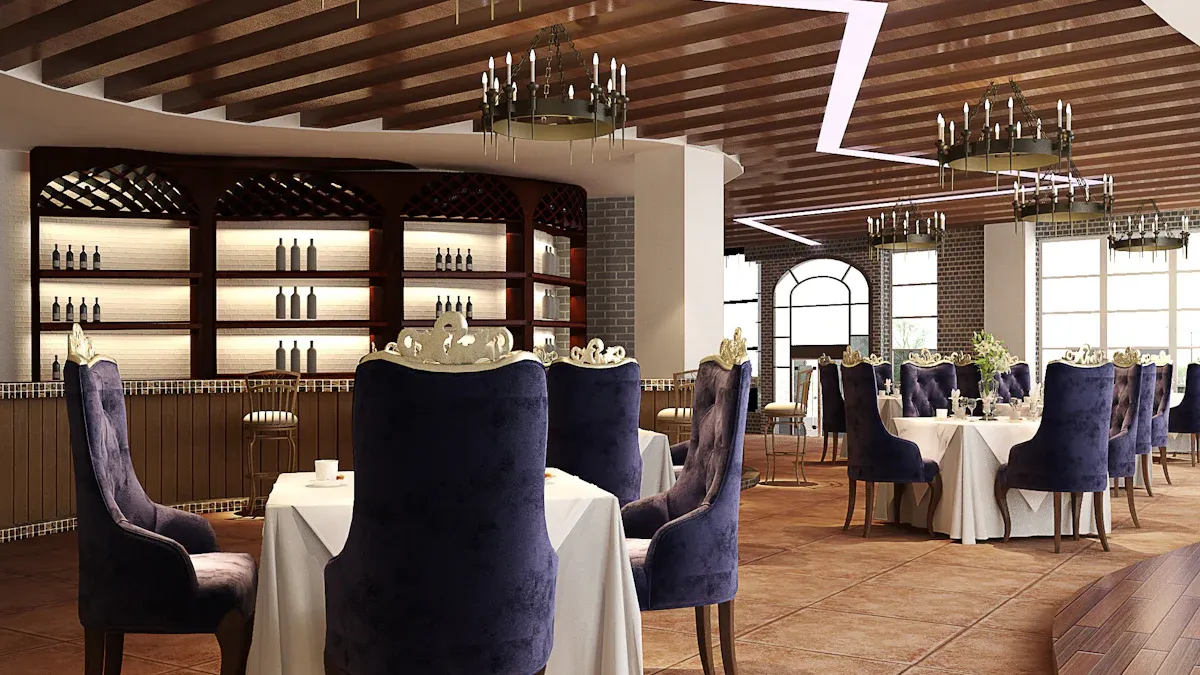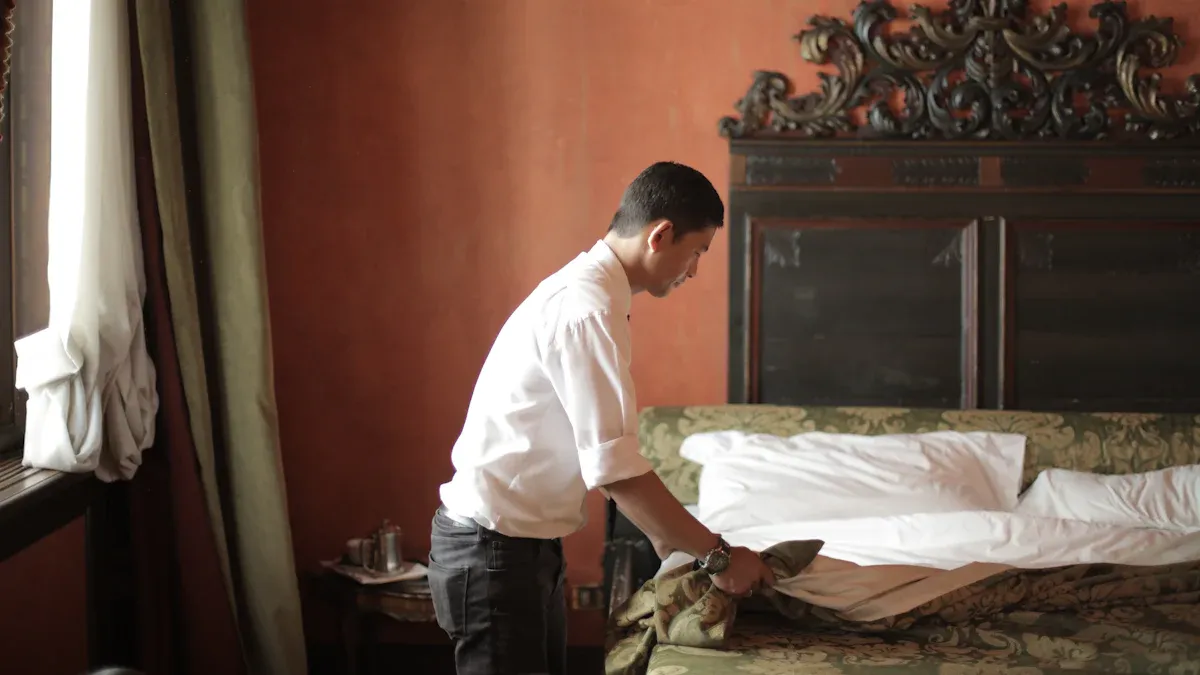
Durable hotel furniture significantly enhances guest satisfaction. Guests appreciate well-maintained and comfortable spaces. Long-lasting pieces also reduce operational costs by minimizing frequent replacements and repairs. Investing in quality hotel furniture maximizes return on investment, ensuring sustained property value and appeal for years.
Key Takeaways
- Choose strong materials like solid wood, commercial metals, and tough fabrics. These materials make furniture last longer.
- Check how furniture is built. Strong joints and good hardware prevent furniture from breaking easily.
- Pick furniture that is easy to clean and has a simple design. This helps it look good and work well for many years.
Prioritize Robust Materials for Hotel Furniture Longevity
Selecting the right materials forms the foundation of durable hotel furniture. High-quality components ensure longevity and reduce maintenance needs.
Selecting Solid Hardwoods and Engineered Woods
Solid hardwoods offer exceptional durability for furniture construction. Oak, maple, cherry, teak, and mahogany are excellent choices due to their inherent strength and resistance to wear. For engineered wood products, plywood significantly outperforms particleboard. Plywood provides superior strength, durability, and moisture resistance. Its layered construction withstands heavy loads and maintains structural integrity. Particleboard, while economical, lacks internal strength for heavy-duty use and is susceptible to moisture damage. Plywood is also lighter, easing handling and reducing stress on furniture structures.
Choosing Commercial-Grade Metals and Alloys
Commercial-grade metals provide essential structural support and aesthetic appeal. Stainless steel offers high corrosion resistance, especially in harsh environments, due to its chromium content. Aluminum forms a corrosion-resistant coating, balancing durability and cost. Galvanized steel features a protective zinc layer, enhancing its resilience over traditional steel. Red metals like copper, brass, and bronze are among the least corrosive, developing an attractive patina over time. These materials ensure furniture withstands constant use and various environmental conditions.
Identifying Durable Upholstery for Hotel Furniture
Upholstery must endure frequent use and cleaning. Fabrics with high abrasion resistance ratings are crucial. A minimum of 30,000-40,000 double rubs (Wyzenbeek method) is recommended for hotel guest rooms and dining areas. Fabrics exceeding 100,000 double rubs are ideal for extra-heavy duty commercial applications. Polyurethane fabrics offer outstanding resistance to wear, chemicals, and UV damage. Microfiber, leather, vinyl, and polyester blends are also excellent choices for their durability and ease of cleaning. Regular vacuuming and immediate stain treatment extend upholstery life.
Opting for Resilient Surface Materials
Furniture surfaces in hotels face constant contact and potential spills. Materials must resist scratches and stains effectively. Quartz stands out as a superior option. It offers high scratch resistance and excellent stain resistance, making it highly durable. Solid surface materials, conversely, are more prone to scratches and stain easily, possessing lower overall durability. Choosing resilient surface materials minimizes damage and maintains the furniture’s appearance over time.
Evaluate Construction and Craftsmanship of Hotel Furniture

Careful evaluation of construction and craftsmanship ensures furniture withstands the rigors of hotel environments. This assessment focuses on structural integrity, hardware quality, and manufacturing standards.
Assessing Frame and Joint Integrity
Strong frames and secure joints are paramount for furniture durability. Dovetail joints are an exemplary choice for stability and durability in woodworking. They are renowned for their durability and aesthetic appeal, comprising interlocking tails and pins. Manufacturers widely use dovetail joints in crafting furniture, cabinets, and drawers. They are a preferred choice for hotel furniture manufacturing due to their quality craftsmanship. These joints are among the strongest woodworking joints. The precise shaping of tails and pins, when bonded with glue, makes them nearly impossible to pull apart.
Inspect Hardware and Fastener Quality
Standard screws, hinges, and bolts often fail under repeated stress in high-impact environments like hotels. Investing in reinforced, tamper-resistant, and heavy-duty hardware and fasteners prevents early failure and extends furniture lifespan. Washers, such as spring, split, or Nord-Lock types, distribute load and create tension, enhancing resistance against vibration-induced loosening. Locknuts, including nylon-insert and metal varieties, resist loosening from vibrations or torque. Thread-locking fluid, an adhesive that bonds bolts to material, also prevents self-loosening. Double nuts, a secondary nut tightened against the primary one, create a locking effect in high-vibration scenarios.
Recognizing Reinforced Stress Points
Furniture in high-traffic zones, such as lobbies, dining halls, and event spaces, experiences significantly more use. These areas require reinforcement with more durable furniture. Unstable or wobbly tables are a common problem, leading to spills and uneven surfaces. Tall cabinets and TV consoles lacking anti-tip designs pose tip-over risks. Manufacturers reinforce corners with extra fabric backing and heavy-duty staples. They also install 18-gauge stainless steel corner protectors on bottom edges where chairs contact the floor. High-density foam (2.8 pounds or higher) for seat cushions and S-springs beneath the foam distribute weight evenly, extending cushion life.
Verifying Manufacturer Quality Standards for Hotel Furniture
Reputable manufacturers adhere to stringent quality standards. ISO 9001 Certification is the leading quality system certification for furniture manufacturers. It ensures consistent quality and helps streamline vendor approval processes. Hotel furniture companies often hold a wide array of certifications, encompassing quality management systems and environmental sustainability standards. These certifications include BIFMA LEVEL® for environmental impact and UL GREENGUARD Certification for low chemical emissions. A robust quality control process involves rigorous material selection, manufacturing oversight, durability testing, and safety compliance checks.
Consider Finishes, Functionality, and Manufacturer for Hotel Furniture
Selecting Protective and Maintainable Finishes
Furniture finishes protect surfaces and enhance appearance. Regular maintenance extends their life. Keep furniture away from direct sunlight and heating vents. Blot spills immediately. Use coasters and placemats. Dust regularly and polish every 4-6 months. For specific materials:
- Wood: Use waxes for long-lasting protection or cleansers for regular care. Avoid lemon oil, which attracts dust.
- Leather: Dust regularly. Use leather-specific cleaning products. For Nubuck, use specialized cleaners to maintain texture.
- Stone: Blot spills immediately. Use stone-formulated cleansers and polishes. Avoid abrasive powders and acidic juices. Do not wax white marble.
- Rattan: Dust with a soft cloth. Vacuum woven panels. Avoid dragging chairs.
Daily cleaning involves dusting with microfiber cloths and disinfecting high-touch areas. Weekly deep cleaning includes polishing wooden furniture with pH-neutral products and vacuuming upholstery.
Ensuring Practical Design for Heavy Use
Practical design ensures furniture withstands constant use. Hardwoods like oak and maple, along with metal frames, provide strength. Reinforced joints, such as mortise and tenon, enhance durability. Simple, clean lines often prove more resilient than intricate designs. Functional aspects like smooth drawer mechanisms also contribute to longevity. Ergonomic considerations are crucial for guest comfort and furniture longevity. Furniture should offer comfort, functionality, flexibility, and accessibility. Beds need quality mattresses. Seating requires lumbar support and appropriate depth. Workspaces benefit from optimal desk height and good lighting. Adjustable features on chairs and beds accommodate diverse body types.
Partnering with Reputable Hotel Furniture Manufacturers
Selecting the right manufacturer is vital. Reputable manufacturers prioritize quality, using durable materials and superior finishes. They offer customization capabilities, allowing unique brand expressions. Commitment to sustainability, with transparent processes and certifications, is also a key indicator. These manufacturers help achieve a luxurious feel within budget constraints. They possess a proven track record, extensive experience, and positive client testimonials. A good warranty from a manufacturer covers defects in materials and workmanship under normal use for at least five years. This comprehensive coverage enhances purchase confidence and indicates higher furniture quality.
Investing in durable hotel furniture offers significant strategic value. Meticulous selection provides long-term benefits, reducing operational costs and enhancing property appeal for years. Quality directly impacts guest experience and boosts profitability, ensuring a strong return on investment for any establishment.
FAQ
What are the best wood types for durable hotel furniture?
Solid hardwoods like oak, maple, and cherry offer exceptional strength. Plywood is a superior engineered wood choice for durability and moisture resistance.
How can one identify durable upholstery for hotel use?
Look for fabrics with high abrasion resistance, ideally over 30,000 double rubs. Polyurethane, microfiber, and leather are excellent choices for their wear and cleaning properties.
Why are reinforced joints important in hotel furniture?
Reinforced joints, such as dovetail or mortise and tenon, provide superior stability. They prevent furniture from loosening or breaking under constant heavy use.
Post time: Nov-04-2025





